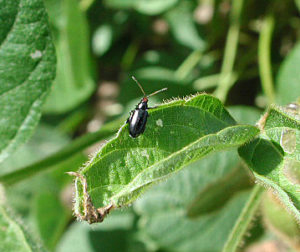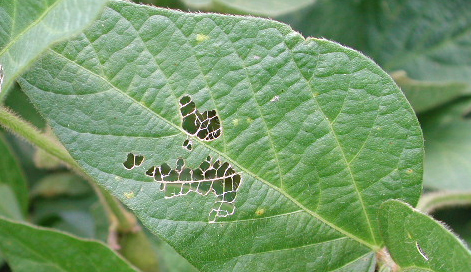Red-headed flea beetles are enjoying a bit of feeding time in soybeans and corn this week.

Red-headed flea beetle adult. T. Baute, OMAFRA
In corn, their feeding is most prevalent in the field border rows, though can scattered throughout the field too. The beetle strips away the leaf tissue causing window-paning, very similar to adult corn rootworm leaf feeding. This feeding is simply superficial and does not warrant control.
In soybeans, red-headed flea beetle feeding appears as tiny holes that connect into a network, making the leaf appear skeletonized. This feeding only warrants control when it reaches the defoliation thresholds for soybeans.


fig1.Red-headed Flea Beetle Feeding Injury on Corn. T. Baute, OMAFRA,fig2.Red-headed Flea Beetle Feeding Injury on Soybeans. T. Baute, OMAFRA
To estimate damage thresholds for leaf-feeding insects on soybeans, determine the percentage of defoliation occurring in each soybean field. In 10 areas of the field, pick trifoliate leaves from five plants in the middle of the plant’s canopy. Discard the least and most damaged leaflets from each trifoliate collected, leaving only one leaflet for each trifoliate collected. Also take note of the crop stage of the plant.
A handy one-pager on defoliators of soybeans can be found here. It includes examples of what the different percentages look like on a leaflet. Defoliation is often overestimated. While assessing defoliation, try to visually move all of the holes to one end of the leaf and determine how much of the leaf would be gone. Rarely have the defoliators warranted a spray in soybeans.
Soybean Defoliation Thresholds

Source : fieldcropnews